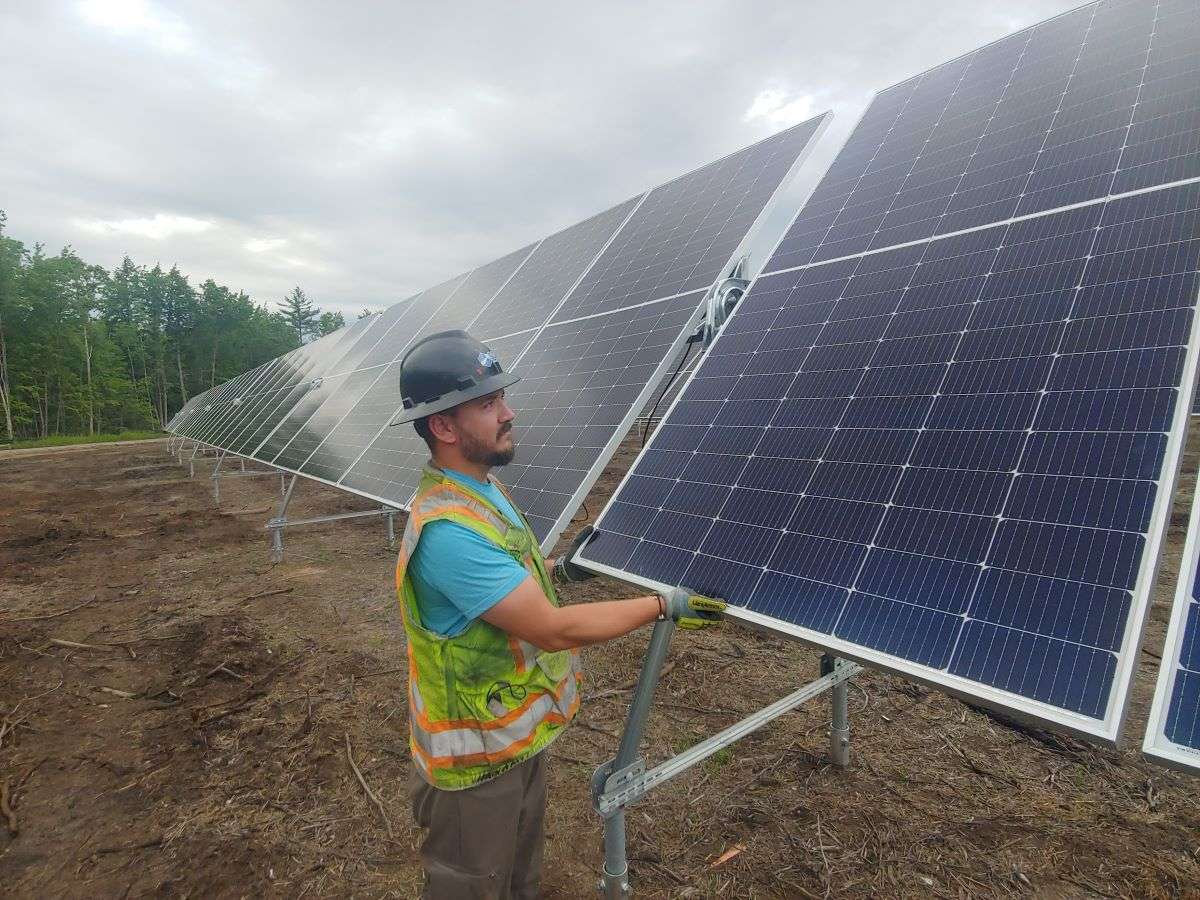Sanford Rises to Top of Solar Heap
- September 6th 2024
- Business News

Dalton Enius of Solar Operation Solutions installs panels at the former CGA site off New Dam Road.
Photo: Lee Burnett
By Alexa Livingston, UNE News fellow
If it seems as though solar farms have been sprouting up everywhere in Sanford, that’s because they have: The City of Sanford has the second-most solar development of any community in the state as of July 2024, with a total of 62.6 megawatts. Only Farmington had more, at 94.2 megawatts.
The projects generate more than $1 million in property taxes for the city, lowering the amount residents must pay. They also help contribute to the higher electric bills paid by ratepayers statewide. (Solar projects take advantage of state tax incentives that contribute to higher electric bills.) The city sees it as a good deal.
“The prevalence of solar in the city is partly the result of more than a decade of advocacy on the part of City Manager Steven Buck as well as the city’s sweet-spot location,” said Dale Knapp, head of Walden Renewables, which has developed several projects in the area.
The city is near enough to multiple 145-kilovolt transmission lines that it’s relatively convenient to wheel large amounts of power onto the grid. But it’s distant enough from congested urban areas that large blocks of land (50 acres or more) are still available for development. “Sanford is uniquely positioned. It’s kind of a balance,” said Knapp.
He added that Sanford’s “development-friendly” business climate facilitates solar Development, although that is of lesser importance. “It really is about transmission capacity and available land, then land use ordinances.”
Buck has been an outspoken advocate for solar’s economic benefits for more than a decade. When he started his tenure as city manager in 2011, the solar industry in the United States was still in its infancy. Prices for panels, which had been prohibitively high, were on a downward slide, ushered along by a federal push to bring large-scale solar costs in line with other forms of energy.
At the time, Maine had few incentives for solar development. The first community solar development was still several years away from coming online and the state was governed by Paul LePage, who would spend much of his tenure battling with advocates over net metering programs, which paid homeowners for installing panels and sending electricity back into the grid.
The project envisioned by officials in Sanford seemed straightforward: 5 megawatts on a closed landfill just off High Street. “That’s all we wanted to do,” said Buck. “In my mind, I had hit the easy button.”
Thirteen years later, the landfill project has yet to be built. But Sanford’s push for it helped bring about impactful changes in state and federal regulations and ushered York County onto the top of the solar heap, neck-and-neck with Kennebec County. As of July, the two counties had 136 megawatts and 138 megawatts of installed solar capacity, respectively, according to figures from the Governor’s Energy Office.
An economic win
Maine’s net energy billing program, in which solar owners are paid for the energy they send back into the grid, has been criticized in recent years for its cost to ratepayers. Bill Harwood, the Maine Public Advocate, has estimated the projects will cost Maine ratepayers roughly $220 million annually for 20 years; roughly $275 per ratepayer per year. Many of the state’s community solar projects have also wound up bundled and sold to some of the world’s largest corporations and investment firms, according to reporting by “The Maine Monitor.”
Advocates for solar projects, however, say they’re an economic boon to municipalities. Sanford’s solar projects are bringing in more than $1.2 million in gross tax revenue each year, according to figures provided by Buck. At a current valuation of $74.6 million, the projects – including the 50-megawatt array at the Sanford Seacoast Regional Airport, one of the largest airport arrays in the nation – bring in $1,214,000 in gross tax revenue. The city expects two more projects to come online in the next year. “There’s a multitude of ways to get an economic benefit out of a well-designed alternative energy project,” said Buck.
Between lease payments, a maintenance and construction agreement, environmental offsets and other benefits, the airport project alone brings in an average of $16,279 per megawatt – more than $800,000 – annually, enough to make the airport entirely self-sufficient.
Buck and then-Economic Development Director Jim Nimon saw the economic promise of solar more than a decade ago, envisioning a 5-megawatt solar project on the dormant landfill, with the premise of a power purchase agreement in which Sanford would lease the land to a solar developer who would sell the electricity generated from panels back to the city at a fixed price.
The city’s ambitions grew as they looked to expand the project to 10 megawatts, with 5 on the landfill and another 5 megawatts on a Brownfield site across the road.
But building solar on old landfills is 10-15% more expensive than siting them on undeveloped land; construction practices must be altered to ensure the site’s protective cap isn’t compromised, which can increase labor costs. The presence of the cap also means that posts typically can’t be driven into the ground but must be stabilized with ballast or mounted on long concrete footings, an additional expense.
Landfills and brownfields, which often have remnants of industrial infrastructure and environmental hazards, may also require more in-depth review than putting posts and panels in an empty field. Landfill projects must be monitored to ensure they do not compromise the site’s integrity in the long term. “So, from a cost perspective, it didn’t pencil out,” said Buck. “It was too expensive.”
Undeterred, Buck delved into legislative advocacy, pushing for state approval for a pilot that would have allowed the proposed project to benefit from net metering, in which solar owners are paid for some of the energy they send back into the grid. The gambit failed; opponents argued that the bill was too broad and would have impacted ratepayers across the state.
In the meantime, however, Buck, Nimon and Airport Manager Allison Navia courted a small developer who had expressed interest in putting panels on the Sanford Seacoast Regional Airport, a roughly 1,200-acre parcel that had 420 acres authorized for non-aviation use.
Just as the city was entering into an agreement with the company, Ranger Solar, the Federal Aviation Administration announced a temporary halt on putting panels around airports, citing concerns about glare that could impede a pilot’s vision.
Apart from the glint and glare issue, the project encountered hurdle after hurdle. Environmental regulations meant the city and the developer needed more land to accommodate the number of panels that would be necessary to make the project economically viable. The size of the proposal also required a new, $8 million substation to handle the amount of power being generated.
“There was always something cropping up—real estate issues, regulatory complexities, state environmental concerns and technical hurdles,” Navia told the trade publication Airport Improvement in an interview in 2021. “The project almost died on a monthly basis for about five years,” she added.
The project’s magnitude and innovation drew the attention of NextEra Energy, one of the largest solar investors in the US, leading to the project’s acquisition in 2017. The 50-megawatt project that went live in November 2020, is one of the largest airport solar projects in the United States.
But Knapp said Sanford may soon reach its solar generation capacity. “There’s a limit to the number of farms because transmission capacity is being used up. Each farm chips away at transmission capacity. The proverbial highway will be full. That day is not too far off,” he said.
Sanford’s pursuit of solar developments comes as other communities around the state are slowing the rush, instituting temporary pauses on development and banning larger commercial arrays. More than a dozen municipalities across the state have paused solar development in recent years, according to reporting by “News Center Maine.”
The city continues to pursue more solar, however and has partnered with Walden Renewables to develop a 5-megawatt community solar project on a remediated Brownfield site that is expected to be online in the coming year. It is also negotiating a TIF district and a credit enhancement agreement with Walden on another 20-megawatt project to make the project more financially attractive to the developers.
“It is much easier for the city to engage with developers on projects now,” said Buck. “We know how to value them. It’s just second nature for us now. We’ve conquered all of these elements.”
This story was reported with The Maine Monitor, whose longer story on solar development can be read here.






